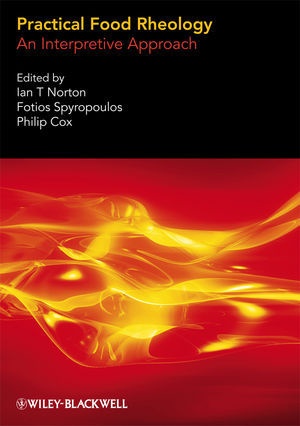Read more
Informationen zum Autor Professor Ian T Norton, Dr Fotios Spyropoulos and Dr Philip Cox, all of Chemical Engineering, University of Birmingham, Edgbaston, Birmingham, UK. Klappentext Food rheology is concerned with the flow of foods that behave in complex ways, and how flow is determined by the material's microstructure. For food manufacturers, rheology is essential to understanding how a substance may be mixed and pumped through pipes during processing, as well as how it behaves in the hands and mouths of the consumer to dictate the food experience. Practical Food Rheology presents this important subject in a new light: with a practice-based, interpretive approach, it examines food rheology in relation to a number of distinct food systems. Resisting oversimplification - yet refusing to overwhelm the reader with equations and mathematics - this book is a practical, concise assessment of how the interpretation of rheological data can improve the actual functionality of food. It provides an overview of the techniques used to monitor rheological and textural properties, then considers the links between food microstructure and rheology, and finally suggests ways in which these properties may be used to alter and improve food texture and performance. Whether the reader is a rheologist or food developer, student or academic, the authors - recognised authorities in food rheology, texture, and microstructure mechanics and engineering - provide expert guidance through the interpretation of rheological data. Zusammenfassung * A uniquely practical approach to the often difficult science of food rheology * Includes chapters introducing the basics of food rheology before moving on to how data can be usefully and easily interpreted by the food scientist * Can be used as a teaching aid on academic or industry-based courses . Inhaltsverzeichnis Preface. Contributors. 1 Introduction - Why the Interpretive Approach? ( Niall W. G. Young ). 1.1 Rheology - What is in it for me? 1.1.1 Case study. 2 Viscosity and Oscillatory Rheology ( Taghi Miri ). 2.1 Introduction. 2.2 Food rheology. 2.3 Directions of rheological research. 2.3.1 Phenomenological rheology or macrorheology. 2.3.2 Structural rheology or microrheology. 2.3.3 Rheometry. 2.3.4 Applied rheology. 2.4 Steady-state shear flow behaviour: viscosity. 2.4.1 Rheological models for shear flow. 2.4.2 Wall slip. 2.5 Viscoelasticity and oscillation. 2.5.1 Oscillatory testing. 2.6 Process, rheology and microstructural interactions. 2.7 Rheology of soft solids. 2.7.1 Capillary rheometer. 2.7.2 Squeeze flow rheometer. 2.8 Measuring instruments - practical aspects. 2.8.1 Choosing the right measuring system. 3 Doppler Ultrasound-Based Rheology ( Beat Birkhofer ). 3.1 Introduction. 3.1.1 Overview. 3.1.2 History of ultrasonic velocimetry. 3.1.3 Existing literature on UVP-based rheometry. 3.2 Ultrasound transducers. 3.3 Flow adapter. 3.3.1 Doppler angle. 3.4 Acoustic properties. 3.4.1 Propagation. 3.4.2 Attenuation. 3.4.3 Sound velocity. 3.4.4 Scattering. 3.4.5 Backscattering. 3.5 Electronics, signal processing and software. 3.5.1 Electronics. 3.5.2 Signal processing and profile estimation. 3.5.3 Software. 3.6 Pipe flow and fluid models. 3.6.1 Gradient method or point-wise rheological characterisation. 3.6.2 Power law fluid model. 3.6.3 Herschel-Bulkley fluid model. 3.6.4 Other models. 3.7 Rheometry. 3.7.1 Averaging effects at the pipe wall. 3.7.2 Fitting. 3.7.3 Gradient method. 3.8 Examples. 3.8.1 Carbopol solution. 3.8.2 Suspension of pol...

